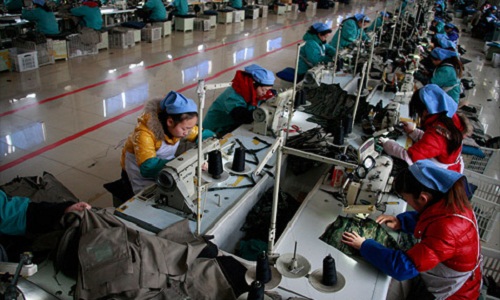FW
"The report says, economic growth in South Asia is projected to strengthen in 2016-17, contingent upon steady progress on domestic policy reforms. Aggregate GDP is expected to grow by 6.7 per cent in 2016 and 7 per cent in 2017, up from an estimated growth of 6 per cent in 2015. The improved outlook is likely to be broad-based. In most economies, including Bangladesh, India, Pakistan and Sri Lanka, strong private consumption will remain the major driver of growth, offsetting relatively tight fiscal policies and weak exports."

The United Nations World Economic Situation and Prospects 2016 report projected South and East Asia to remain the world’s most dynamic and fastest-growing region in 2016/17, despite the recent economic slowdown. The UN report said, as the world economy continues to face considerable headwinds, the external environment for most economies in the region will remain challenging. In 2015, sharply lower commodity prices, weak trade activity, large capital outflows and increased financial market volatility weighed on aggregate growth, which fell to the lowest level since 2001. Aggregate growth in East and South Asia is forecasted to pick up slightly from 5.7 per cent in 2015 to 5.8 per cent in both 2016 and 2017 amid a modest improvement in global growth.

According to the report, a key risk to the regional outlook is a sharper- than- expected slowdown of the Chinese economy, which would negatively impact trade and investment flows in East Asia. Another risk factor is related to the monetary policy normalization in the United States, which could lead to renewed financial turmoil or a tightening of liquidity conditions across the region.
Growth in South Asia to strengthen, led by India
The report says, economic growth in South Asia is projected to strengthen in 2016-17, contingent upon steady progress on domestic policy reforms. Aggregate GDP is expected to grow by 6.7 per cent in 2016 and 7 per cent in 2017, up from an estimated growth of 6 per cent in 2015. The improved outlook is likely to be broad-based. In most economies, including Bangladesh, India, Pakistan and Sri Lanka, strong private consumption will remain the major driver of growth, offsetting relatively tight fiscal policies and weak exports. Some country-specific factors, such as the lifting of international sanctions against the Islamic Republic of Iran and reconstruction spending in Nepal, are also expected to support economic activity during the outlook period.
India’s economy, which accounts for over 70 per cent of South Asia’s GDP, is projected to grow by 7.3 per cent in 2016 and 7.5 per cent in 2017, slightly up from an estimated 7.2 per cent in 2015. As in other countries of the sub-region, the mac¬roeconomic environment in India has improved over the past two years, helped by the sharp decline in the prices of oil, metals and food.
As a net oil-importing region, South Asia has seen reduced inflationary pressures. Average consumer price inflation slowed from 8.2 per cent in 2014 to 6.2 per cent in 2015, the lowest level in more than a decade. Upward price pressures are expected to remain muted in the short run. Amid lower inflation, monetary policy has been loosened in several economies, most notably India. While room for further easing is relatively limited, monetary policy is projected to remain accommodative in most countries.
Budget deficits in most South Asian economies are expected to further moderate gradually in the wake of low oil prices, stronger economic activity and rationalization of fuel subsidies. Nonetheless, fiscal positions remain fundamentally weak and further reforms are needed to enhance the fiscal space.
East Asia projected to see steady growth
The report suggests, East Asia is forecast to see solid Gross Domestic Product (GDP) growth of 5.6 per cent in both 2016 and 2017 – about the same rate as in 2015, but significantly below the average of 6.3 per cent recorded in 2012-14. Further moderation in China’s growth is expected to be offset by a pickup in activity in some other large economies such as Hong Kong Special Administrative Region of China, Indonesia, Taiwan Province of China and Thailand. Given protracted weak demand in most developed countries and global financial market uncertainty, East Asia’s economies will continue to rely on domestic and regional sources of growth, including more expansionary fiscal policies.
However, economic growth in China is expected to further ease from an estimated 6.8 per cent in 2015 to 6.4 per cent in 2016 as the economy undergoes a structural transformation towards a more balanced and sustainable growth path.
The economies of Taiwan Province of China and Hong Kong Special Administrative Region of China have posted weak export performances over the past year. For both economies, a pick-up in exports and steady private consumption growth are expected to drive moderate growth recoveries in 2016/17. Among the bright spots in the region have been the economies of Myanmar and Vietnam, where growth-supporting factors, such as new investment and strong consumer spending, are projected to remain in place.
This year’s Interfiliere Hong Kong will dedicate insightful knowledge on modern corsetry to exhibitors and visitors. In addition, the event will celebrate the ‘Modern Corsetry’ in all possible aspects exploring its charisma, creativities and performances. Corsetry has revived in the modern trend with exceptional features and elegance. The show will create an informative and interactive platform bringing together products with high quality from fabric, lace, accessories, embroidery and OEM/ODM sectors.
During the event, ‘The Exception and OEM’ Fashion shows will be the new features to be expected. Surprising, inspiring, stimulating and imagining projects are expected to be revealed in Interfiliere Hong Kong 2016. The show will bring jacquard into the spotlight. Educative information on the history of profession, the graphic software and machinery will be illustrated in the Jacquard pathway.
Prototypes Fashion Shows will return to the trade show for the second time. The show will collaborate with Concepts Paris bringing attention to Shapewear. For the very first time, OEM Fashion Shows will be presented in Interfiliere Hong Kong showcasing the latest products with innovation, inspiration and know-how. Another feature of this year’s event is the seminar and conference programs in collaboration with professionals will share informative knowledge on trends, current and future market.
Interfiliere Hong Kong launched its first show in 2007. In the past 10 years, it has created a community gathering professionals around the world and empowering numerous customers to exchange ideas and fulfill their business needs. Scheduled to be on 15-16 March 2016, the event will be held at the Hong Kong Convention and Exhibition Centre.
Most cotton ginning and pressing factories in Maharashtra are functioning at 50 per cent capacity because of low arrivals of cotton in the market. Farmers have sold only 40 per cent of their stocks in the ongoing season and are still holding on to 60 per cent of their produce. Moreover, several petty traders from Gujarat have been purchasing cotton from Maharashtra, resulting in low arrivals.
There is a lot of disparity in the market as a result of which ginning and pressing units are finding it difficult to keep their units up and running. Maharashtra has over 1,100 units and only 450 units are functioning at 50 per cent capacity. This is because farmers are not getting the price they want and holding on to their stocks for better prices.
Maharashtra processes about 80 lakh bales annually. Around 60,000 laborers are working in these units and most of the units are located in Marathwada. Maharashtra has a capacity of producing one crore bales. Farmers have sold some 80 lakh quintals of cotton to traders so far. Because of the low arrival position, ginning and pressing units are expected to close early this season, by February. Factory owners are making losses of Rs 75,000 per 100 bales and are finding it difficult to survive.
Around 1,000 of the 33,000 power loom units in Coimbatore and Tirupur districts of Tamil Nadu have become sick units. And a a few thousand more units are in deep debt, with interest mounting every day. The situation is fast worsening. The monthly interest alone comes up to Rs 20,000 a month. This apart from the amount paid for labor, electricity bills, replacing spare parts and paying for dyeing, fitting, knotting charges.
A large number of units have not been able to pay off their bank interest regularly and that keeps accumulating over the years. In 2014, textile units had reached an agreement with power loom unit owners, whereby textile units would give a 30 per cent hike in job working charges. But this arrangement lasted for hardly three months. The textile units then went back to their old rates claiming business was dull. Textile unit usually give power loom units the yarn to be spun into fabric.
An average unit with around 10 looms gets to weave around 600 meters of cloth. It gets paid about Rs 5 a meter but labor and other charges have to be paid and working costs like electricity, spare parts, knotting and dyeing have gone up.
The textile industry in India has warned the government that if goods and services tax (GST) is levied on maximum retail price (MRP) as proposed, it would have multiple ill effects on the entire sector. The industry has recommended the government to levy GST on ex-factory price, which is always much lower than the MRP, as it would leave some leg room for periodic discount offers. The textile industry offers heavy discounts on MRP of branded garments not only in their factory outlets but also in organised retails to attract business. Even branded garments are available at affordable prices especially in the lean season which otherwise remain un-affordable for the average middle class buyers.
Considering expenses incurred on branding, transportation and a host of other aspects, it is important to have GST levy on ex-factory, which would be determined on the basis of actual manufacturing cost. The ex-factory price can easily be arrived at on the basis of the current system of Central Sales Tax (CST) paid to the government, industry represented to the Finance minister Arun Jaitley.
The industry has also urged the government to keep this employment intensive industry in the lowest slab of GST. Trade sources believe that 12.5 per cent of GST would be a logical level without any ill-effect on the industry. India's textiles exports are set to record a marginal decline at $40 billion in the financial year 2015-16 as compared to $41.4 billion reported in the previous financial year.
In a recent development, Pakistan’s Chairman of Standing Committee of the National Assembly on Textile, Khawaja Ghulam Rasool Koreja threatened to resign if the government fails to resolve the issues facing the industry. Koreja, talking to the office bearers of the Pakistan Hosiery Manufacturers Association (PHMA) recently said the committee will call officials of finance and commerce ministries as well as the Federal Board of Revenue (FBR) to discuss the matters especially related to sales tax refunds.
The Standing Committee’s chief, heading a 19-member delegation, assured the representatives of the value-added sector of solving their problems. Koreja said the committee will also hold a meeting with the Prime Minister and Finance Minister apprising them of the sensitivity of issues. He identified four issues pertaining to value-added textile sector, including refunds, export development fund, new markets and cost of production. He also constituted a sub-committee to discuss the difficulties with other representatives of the value-added sector.
Standing Committee member Abdul Rashid Godil said sales tax threshold should be eliminated and a reduced and uniform rate should be introduced. Godil said that he had raised voice for the important sector but it appeared that the government was more focusing on trading instead of manufacturing.
The global smart textile market is projected to expand at a remarkable CAGR of 30.80 per cent during 2015 to 2023. Smart textiles are fabrics that come embedded with electronics that are connected with each other.
The use of nanotechnology has grown tremendously in the smart textile industry due to its valuable and unique properties. It enables textiles to become multifunctional and supports embedding electronic components into the fabric. In addition to this, nanotechnology supports the production of fabrics that come with special functionality such as water and stain resistance, UV protection, and anti-bacterial.
Smart textiles are materials and structures that sense and react to environmental conditions or stimuli, such as those from mechanical, thermal, chemical, electrical, magnetic or other sources. The technology of smart textiles is an integration of almost all disciplines of applied sciences like textile chemistry, fiber technology, telecommunication, artificial intelligence, organic chemistry, electronics and instrumentation, molecular engineering and nanotechnology and biotechnology.
Smart textiles, however, are not just restricted to clothing and apparels. They extend to many other applications like automobiles, robotics, aircrafts, medicine and surgery. Military clothing that can change color in order to produce camouflage effects for protection uses smart textiles.
Many garment units in Bangladesh are not submitting tax returns, pointing to the fact that tax compliance is poor in the country’s main export industry. There are 4,500 readymade garment companies operating in Bangladesh, including knitwear and woven factories, and about half of these do not submit returns. There is a suggestion that the various incentives the sector is given should be linked with tax compliance and only compliant companies should be eligible for enjoying incentives.
Right now tax at source is deducted at the rate of 0.60 per cent on export bill of apparel exporters. Later, exporters adjust the amount by calculating their income at regular corporate tax rates of 35 per cent. Until June 30, 2014, exporters had enjoyed a special rate of tax at 10 per cent at the time of calculation of their income. Apart from export-oriented garment industries, local garment companies have to pay tax at regular corporate rates.
However, BGMEA, the association representing garment owners says none of their members are defaulter. BGMEA says all readymade garment companies submit tax returns and that members can renew their license only by submitting a copy of the tax receipt. The association says there may be pending cases with some companies due to disputes with the taxmen that causes delay in submission of tax returns.
India’s overall exports of textiles and clothing in 2015-16 may be similar to last year's level. The slowdown in China may be an opportunity for India. However there is a need to act fast since India is losing share to Bangladesh and Vietnam.
For instance, with a 13 per cent share, technical textiles is emerging as a sunrise sector. The technical textile industry is projected to grow at 20 per cent year-on-year and the segment’s potential is largely untapped in the country.
Exports of readymade garments are expected to reach $17 billion in 2015-16 as against $16 billion in the previous year. The domestic apparel industry is facing slackness but sentiment is likely to improve after implementation of GST.
The country's exports to South America, Eastern Europe and Middle East have increased significantly, but uncertainty still prevails in Europe, which is a major market. Several larger overseas buyers wanted a reduction in prices in the wake of a drop in cotton prices.
Exports of readymade garments from India grew faster than China for most of 2014. Also, India is emerging as one of the top sourcing and compliant destinations for buyers in the world.
Japan’s Mimaki wide format manufacturer that develops and manufactures industrial inkjet printers and distributes them throughout the world is set to acquire Italian textile machine manufacturer La Meccanica Costruzione Tessili. This would strengthen Mimaki’s position in the global textile printing market. The conclusion of the formal agreement is expected to take place by the beginning of March.
The acquisition was first mooted in July 2015, when an Italian sales agent introduced Mimaki to La Meccanica, a manufacturer of conventional and digital textile printing machines. La Meccanica was established in 1977. The acquisition is aimed at further expanding Mimaki’s positon in European textile and apparel market.
The company has also unveiled the super-wide format TS500P-3200 inkjet printer, a dedicated transfer paper printer for the textile industry, with applications including home furnishing textiles and indoor soft signage.
Mimaki has been involved in textiles since 1998. It has shown its products at international textile manufacturers’ trade fairs. Textiles in general and fashion, home interiors and soft signage are all giving the company tremendous growth in different areas; soft signage in western Europe, fashion in eastern and Asian countries and home interiors in Turkey, Bulgaria and Romania.
eng.mimaki.co.jp/












